Art Silverman
Glider Pilot
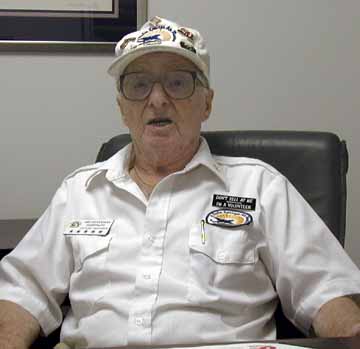
Webmaster: When were you born?
May 18, 1913.
Webmaster: Where?
Chicago, Illinois.
Webmaster: You went to school in Chicago?
No, I left Chicago as an infant and grew up in New York City.
Webmaster: Where in New York City?
Downtown Manhattan.
Webmaster: You attended school in Manhattan through high school?
Yes, all in downtown New York City.
Webmaster: You must know Manhattan well?
I do. Very well.
Webmaster: You have quite a sense of humor. I understand your dad was a comedian?
No, that was my mother. My dad was a machinist for the Underwood Typewriting Company for twenty-seven years.
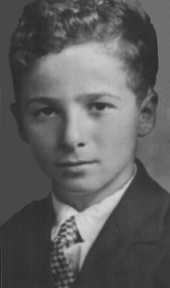
Webmaster: Oh! Then you get it from your mother. Were you in the service before they bombed Pearl Harbor?
No, I was flying. I had a little Luscombe and was flying that Sunday morning when they bombed Pearl Harbor. I remember saying to my friend who was flying with me, "Where is Pearl Harbor?" Neither I nor he knew where it was. We were city boys. When we landed, we got all the info.
Webmaster: You were interested in flying long before your entry into the military. Did you have a Private Pilot's License?
Yes, I got it in 1941.
Webmaster: So you are out of high school and have a Private Pilot's License. What interested you in flying?
Lindbergh. When he made that flight in 1927, that got my juices flowing and I was determined to fly. I would go out to Roosevelt Field in Mineola. That is the field Lindbergh took off from on his famous flight. On that field were a few flying schools and I chose one and learned to fly for $5.00 per hour wet and with an instructor. It is a lot more now.
Webmaster: You were twenty-eight years old when they bombed Pearl Harbor? Was Pearl Harbor the event that motivated you to go into the service?
Yes, I wanted to do my part. When I was ready to be inducted into flight school, I was put into the enlisted reserves and not called for about a year. I kept calling them and asking when I could go and was always told to have patience. I told them I didn't want to have patience, I wanted in the active service.
They finally called me and told me to report to Camp Yaphank. I had to go down to Whitehall Street where the recruitment offices were. I enlisted in the Air Corps. It was one of those Mickey Mouse camps. It wasn't bad. There was enough room in the tents. I stayed there about three weeks getting uniforms, shots and doing calisthenics.
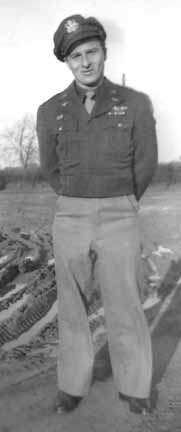
Webmaster: Your goal was to get into cadet flight training?
Yes, they sent me to Bowman Field, Kentucky for about two months. That was intensive ground school. We did very little flying but mostly school and calisthenics. Every morning we got calisthenics as soon as we got off the cot.
I then went to Greensboro, North Carolina which was more school and some flying in the PT-17 Stearman. From there I went to Goldsboro, North Carolina. I had more flying instruction however I was advised all the advanced schools were filled.
Webmaster: When was this?
The middle of '43. I told them I would take any opening they had. Either single engine or multi-engine. I had originally signed up for single engine but if multi was all that was available, I would take it. I wanted to fly anything. He said the only thing they have open is gliders.
Webmaster: You went from single engine to multi-engine to no engine?
They explained to a group of about twelve of us that the glider was a large airplane and we would really be flying it. This airplane would be carrying heavy loads such as jeeps, personnel, munitions and fuel. The instructor took out a film and showed it too us. We looked it over. It was flying. We had five instruments in the glider but no communications and no battery. You couldn't attract the attention of the pilot in the tow plane. Before the flight, they would brief you on what they were going to do. If the weather was bad, they did what they had to do. We would have to guess. We just followed the rope.
While in Goldsboro, we flew in all kinds of weather behind the C-47s.
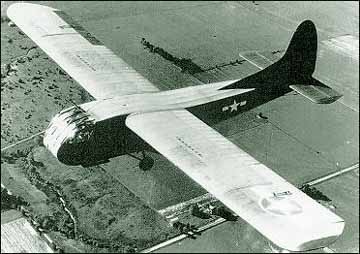
Webmaster: Did you fly CG-4a's?
Yes, they taught us to fly the CG-4a then they started adding weights to the glider. We started with 1000 pounds then they would add another 500 pounds until you reached 2500 pounds. The airplane weighed 3700 pounds and according to the instructor, the glider would carry more than its own weight but we never carried more than 2500 pounds.
Webmaster: How long did you train?
Fifteen hours of flying time over a period of three months.
Webmaster: That's not much?
We had plenty of gliders but we didn't have tow ships. We were at the mercy of the Troop Carrier Command and they didn't have the planes available.
By the way, the landing gear wasn't the strongest gear. You could jettison the gear if you chose to. You didn't have to worry about hydraulic fluid because you didn't have any. The breaks were mechanical. If it was necessary, you could just dump your wheels and land on the skids.
Webmaster: What was your landing speed?
Average speed would be about seventy miles an hour. It was according to your load. A light load, you would land slower.
Webmaster: Were these planes fairly maneuverable?
You could roll and loop them but very few fellows tried it.
Webmaster: But you could pick a landing spot and had the control to hit it?
Oh Yes. We had no trouble getting in. You did have to watch out for other gliders around you which might be heading for the same spot. Remember, you had no intercom to talk to the other pilots. You had to use your eyes.
Webmaster: Did you have good visibility?
Excellent visibility.
Webmaster: Now you are down in Texas. Is that where you graduated and what rank did they award you?
In Lubbock, Texas, I became a Flight Officer.

Webmaster: What insignia did you wear?
It looked like a warrant officer's insignia. We had a similar bar with a blue background. We called ourselves, "third lieutenants."
Webmaster: This was in late '43.
After graduation, I got 30 days leave. I went home then returned to North Carolina.
Webmaster: At this point, we are seven months away from D-Day?
By now, we had all the training they could stuff into a human being which included infantry training. We attended the same basic infantry course as the regular infantry. Our rifle was the M1A1 and we learned how to use it very well.
Webmaster: Where did the infantry training occur?
Fort Knox, where all the money is.
Webmaster: This was after you graduated from flight school?
Yes. Infantry training was rugged. Some of our fellows were hurt. They got their butts too high and were shot during the infiltration course. We had the rifle and pistol range. We learned to use the BAR and various other weapons used in the front. Once that glider lands, we were officially in the infantry. We were no longer airmen but infantrymen. We were walking and carrying an M1 with bayonet.
Webmaster: Sounds like infantry to me?
We were infantry even though they would not allow us to wear infantry insignia.
Webmaster: During all of your training, did you know what you would be doing with that glider?
Not the slightest of an inkling. They did not tell us anything. They did tell us that the German's had gliders and had used them early in their war. Those gliders held two-hundred men and were towed by three twin-engine aircraft.
Webmaster: I believe that was during the invasion of Belgium?
The German's lost a lot of men in using those gliders. Hitler put a stop to it because it was too dangerous. We also had gliders in the Pacific. Those were also CG-4a's made by both Waco and Ford. Ford made thousands of them. They cost about $14,500 each at that time. Only a few years ago they needed one wing for a glider in restoration. They wanted $150,000 for the one wing.
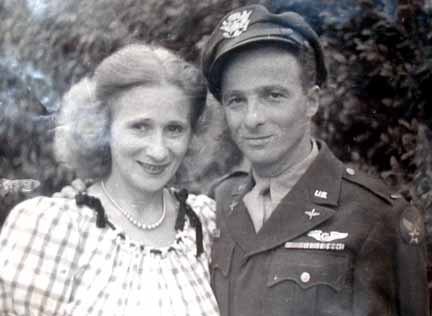
Webmaster: So now you're through training and on your way to England.
We were on an oiler crossing the Atlantic in the winter. It was a rough and cold voyage to South Hampton. We were put on trains entirely blacked-out. Everything was blacked-out those days. It was eerie. We arrived in Stone, England and ended up in different outfits. Everything we did was in the dark except in the huts where we had black-out curtains. Stone is north of London. From there, I went to Grantham where Margaret Thatcher was born. Thirty miles from there was Nottingham where Robin Hood was supposed to have lived. There were no trees in Sherwood Forest.
Webmaster: The clear cutters must have been there before you.
We were at Grantham for a couple of months then one night we were alerted that we couldn't leave the base. We were ordered to get our equipment together. We were issued heavy wool sweaters and caps along with other necessities. We were shipped to Perry Field and now everything was hush hush. We were supposed to go the next day but, as you remember, the weather was bad so they delayed the invasion to June 6. Also Eisenhower issued and order that all the invasion planes be painted with black and white stripes. Two black and three white stripes. Stripes had to be painted on top of the wings, on the bottom of the wings and half-way down the fuselage. Each stripe had to be 2 1/2 feet wide. Everybody had to paint, officers, pilots, enlisted, mechanics, cooks--everyone painted. We painted thousands of aircraft in two days.
The reason for that was due to what happened in Sicily and Salerno. Our own Navy was shooting down our planes. So Ike wanted all planes ID'd so the Navy could recognize them.
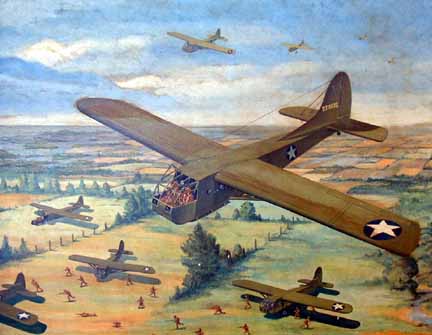
Webmaster: How many gliders were involved in the invasion.
I think the number was about 1500. We were short co-pilots so many of us flew solo including me. Because the strain of holding the controls, after 20 minutes of flying we ached all over. This day, we flew for 2 1/2 to 3 hours.
Webmaster: What was your cargo?
I had a jeep completely filled with medical supplies. The jeep was to go to a medical company. In addition to the jeep, I carried the jeep driver and two general mechanics along with their tools.
Webmaster: In what unit were you placed?
61st. Troop Carrier Group, 15th Troop Carrier Squadron.
Webmaster: So now you are being towed across the channel. What time was this?
About 2:00 in the morning. It was cold and damp and misty. There is no heat in those gliders. A few gliders had an electrical cable wrapped around the tow rope for intercom purposes. This was usually on the lead gliders known as "pathfinders".
Webmaster: We are now on our way over the channel. It is four or five in the morning as you cross over land. How far inland did you go before you released from the tow ship. I understand it was you who released from the tow rope and not the tow plane?
Yes, we released after we crossed Utah Beach inland not far from one of the 82nd Airborne's drop zones. The Germans weren't expecting us. They thought we were going into Calais which was quite a ways from where we did come in.
Webmaster: Your landing was successful. You greased it in?
My landing was good but I hit a building which spun me around and I hit a tree but it didn't hurt the front of the glider. That is where you unload a glider. The cockpit rises out of the way and they drove the jeep out. It was up to me to make sure that the cargo is unloaded and on its way. After that, I picked up my M1 and started searching for an infantry unit.
It was chaotic. Gliders landing everywhere in the dark. Vehicles, cargo and personnel unloading from the planes. Some gliders were demolished in the landing. We didn't know where we were. We were supposed to meet up with a trailer but we couldn't find it. The jeep sped off and everyone was running around trying to figure out where to go and what to do. We slogged around in the mud.
Webmaster: Glider pilots?
Yes glider pilots but also the Airborne Infantry that we were carrying. They were supposed to go find the other guys but they had no idea where to look.
When the Germans found out we were landing there, they came at us from all sides. Remember that the Germans had five years of combat experience and we had none. We were like a bunch of farmers who just stepped into a big city. We didn't know what to do but look around. We were accustomed to comfort. Here is was muddy and cold. We slipped and stumbled in the mud and were ducking the Germans. Finally about five or six of us got into tall grass and were pinned down by gunfire. Every time I moved slightly and the grass around me moved, the Germans started shooting.
Finally a tank company came in and wiped them out. There I was huddled in the grass with a big smile. Concrete, bags and bodies were flying into the air from those German positions as the tanks blasted them. Those tanks saved us.
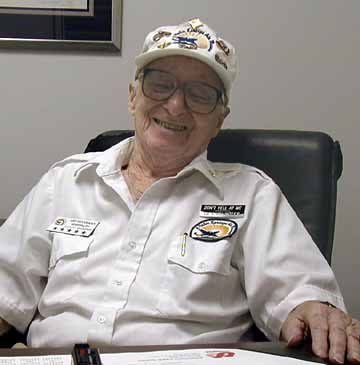
Webmaster: Where did you go next?
I got into an outfit that was only officers--generals down. It was a clean little building. They wondered what a meager flight officer was doing there? I told them I was a glider pilot and they all gave me a whack on the back. "Thank you! Thank you!" they said. They needed the supplies we brought and expressed their appreciation.
They gave me a job as a traffic cop. An MP on a motorcycle gave me a map so I could find where I was to direct traffic. Vehicles were slogging through the mud, getting stuck and had to be pushed off to the side. Eventually I was relieved and assigned to a tank unit. I walked along the side of this tank for about five miles until I was worn out. I told the driver and he stopped another tank that was going back to England. He told me I had a ride home. I rode that tank back to the Channel where I boarded an LST. They couldn't accommodate the tank.
The things that I saw there. Remember, it is now late in the afternoon of D-Day. Bodies, fellows laying on the beach crying. Bones sticking out here and there, body parts laying around. It was horrible.
I got on the LST and I asked him where he was going. He answered, "Dover," and I said, "that is exactly where I want to go."
Webmaster: You flew two other missions?
One was over Holland several months later which was a rough one also. That was under Montgomery who fouled everything up.
Webmaster: Your third mission?
Southern France. Once we got through with Normandy, there were very few glider missions. A lot of C-47s were shot down and that was one limiting factor.
Webmaster: When did you come home?
Our war was over about the middle of May and I came home in August. When you enlist, you enlist for the duration of the war plus six months. That does not mean you have to put in the six months but it is at the army's option.
Webmaster: After your re-entered civilian life, what did you do?
Went into the car business.
Webmaster: Thank you for your time, Arty, and thank you for your service to our country.



|